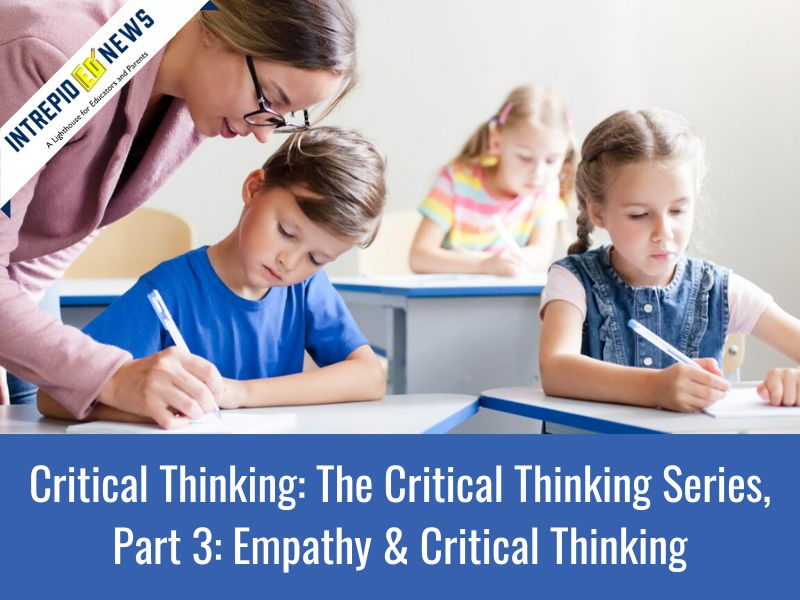Critical Thinking: The Critical Thinking Series, Part 3: Empathy & Critical Thinking
This article is republished with permission from IntrepidEd News
Augusta Moore
So far in this series on critical thinking, we have developed a clear and specific definition of the skill as well as showing how a particular pedagogical tool, argument mapping, can be utilized to increase students’ critical thinking skills. The purpose of this article is to motivate the teaching of critical thinking even further by appealing to the interconnectedness of critical thinking and an important social-emotional skill, empathy. We will ultimately argue that through the teaching of critical thinking skills educators can also encourage their students to become more empathetic towards others. This is because the process of exercising empathic concern requires the same skills that are needed to think deeply and engage in critical thinking.
An example of an exercise that helps students develop both empathy and critical thinking skills is the Disagreement Project, as developed by ThinkerAnalytix. The purpose of this exercise is to provide students with an opportunity to engage with someone who disagrees with them about a significant issue and ultimately gain a deeper understanding of their position. I had the opportunity to participate in such an exercise two summers ago through a teacher training seminar that was run by ThinkerAnalytix. I chose the topic of police reform (which was then and still continues to be at the forefront of our national discussion of minority rights) and found a willing partner with whom I deeply disagreed. We spent half an hour discussing the issue during which my goal was to listen, better understand, and record her positions on the issue.
But that was just the setup to the actual activity, for the Disagreement Project has been designed to not only encourage discussion but also to help students develop the ability to synthesize what another says into an argument map so as to better understand and analyze their position. After the discussion with my interlocutor, I wrote down their argument to the best of my ability and submitted the writing for their approval so as to ensure that I truly heard and understood what they had said during our discussion. From there I created an argument map in which I deconstructed what they had said into their main premise and associated sub-premises. The goal was to create a map that captured the strongest possible interpretation of their position as I understood it.
There are two main benefits to such an exercise. The first was that it engaged my critical reasoning skills as I worked to analyze what they said so as to better understand how their various claims supported their ultimate position on police reform. This required me to think carefully about the problem of police violence and internalize the reasoning behind their proposed solution. The second benefit was that I ultimately came away from the discussion with a deeper understanding of the position and respect for my partner. Creating the argument map required that I place myself in their position so as to better recognize the rational connections that they were making from one premise to another. I came to realize that, while we disagreed, my partner’s position had been carefully and thoughtfully developed and that their rational argument posed serious and substantive questions for my own. I ended that project with a sense that their position was valuable and worthy of consideration. In other words, my ability to connect with my partner on an empathetic level was increased.
My understanding is that the Disagreement Project is an exercise that develops both critical thinking and empathetic skills. However, we ought not to think that such a project does these two things separately. Rather, the Disagreement Project developed both of these skills together, one skill reinforcing the other. In order to see how these two skills are connected it is important to first define empathy. Empathy is an imaginative, emotional skill that allows us to place ourselves in the position of others to try to understand their point of view. One is empathetic if one does not rely on one’s own personal experiences alone but strives to shift one’s point of view to better understand all relevant perspectives, including other people’s experiences, thoughts, and emotions. Empathy requires self-awareness, flexibility, and willingness: an awareness of the differences between one’s own perspectives and others’, the flexibility to understand that they may be affected by a situation differently, and the willingness to take on or understand those differences and recognize that the experiences of others are relevant and valuable. Empathy is not just a general habit or state of being, but rather an active skill that must be exercised when learning and understanding different points of view.
The skills required to exercise empathic concern are some of the very skills that we use when engaging in critical thinking. To see why this is the case it will be helpful to return to our very first article on critical thinking and the definition of the skill. In that post, we amended Dewey’s definition of critical thinking as a problem-solving process to include the necessary condition that students keep an open mind when evaluating possible solutions. This meant that, in order to engage in critical thinking successfully, students must consider solutions from other perspectives, listening to the experiences of others, and gathering data from outside of their own personal environment. The purpose of doing so was to ensure that students would find the most effective solution to the proposed problem. If students were to simply consider solutions consistent with their own experiences then their pool of potential solutions would be limited in ways that the students wouldn’t be able to see or account for. When students approach potential solutions with an open mind and actively seek out other perspectives then it is more likely that they will find the ideal solution to the problem. (This is what makes the ability to understand others and find their experiences valuable and relevant to be necessary, though not sufficient, to the process of critical thinking.)
The skill of seeking out the experiences of others in order to understand different perspectives is exactly the same skill that we employ when exercising our empathic concern. The development of empathy requires that students exercise their capacity to place themselves in the shoes of another. This is similar to the process of working to understand the perspectives of others in order to gather potential solutions to problems. In both cases, creativity is required because students must imagine what it would be like to find themselves in a different environment with different experiences, values, and beliefs. To return to the Disagreement Project, this exercise is able to encourage students to develop both of these skills because it requires that students place themselves in the position of their partner so as to better understand and best represent their position. For example, requiring that the collocutor sign off on the written summary of their argument before continuing to the next step encouraged me to try to reproduce the strongest possible interpretation of what they argued for. Moreover, creating the argument map helped me to recognize and better appreciate the logical connections between each step of their argument and understand that, while I disagreed, the position was rational and worthy of consideration. In this way, by critically analyzing their position I came to have a deeper appreciation for my interlocutor and greater respect for what they had to say.
Empathy is an important skill, necessary for students to achieve success in their personal and working lives. If it is the case that educators ought to give students the skills to build the kind of personal and work lives that they imagine for themselves, then educators should seek to model and encourage empathy within their students. Empathy and critical thinking are both creative, deep thinking processes that must be modeled by educators within the classroom and, fortunately, they can be modeled in tandem. This is because of the similarities in both method and content. Both empathy and critical thinking require that students become more familiar with the perspectives of others and that is very doable, in both cases, through imagining themselves in the position of another.

















Add comment